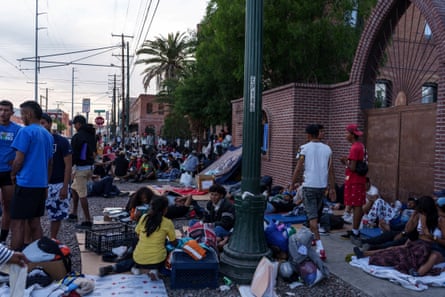The Texas border city of El Paso has declared a state of emergency ahead of the Biden administration’s ending of Title 42 pandemic-related rules next week that, since 2020, have barred many migrants from crossing into the US to exercise their right to request asylum.
City leaders are preparing for a potential influx of more than 35,000 asylum seekers currently stuck in the Mexican sister city of Juárez, after the scheduled 11 May lifting of the emergency public health regulation that was meant to curb the spread of Covid but had severe consequences for hundreds of thousands fleeing to the US from crises in their home countries.
Title 42 was activated in 2020 by Donald Trump and allowed US authorities to essentially close official border entry points to most who just turned up, while swiftly expelling migrants who crossed illegally elsewhere. The policy has been continued by Joe Biden amid legal challenges and Republican anti-immigration invective, with the Democratic president criticized from the left for employing increasingly harsh rhetoric and strategies around the border.
Now emergency shelters and migrant advocates in El Paso fear more of the chaos that occasionally hits the city and overwhelmed services last Christmas when families in dire straits, frustrated at being shut out of US legal systems, waded across the Rio Grande that forms the US-Mexico border there.
Meanwhile, Texas’s rightwing governor, Greg Abbott, plans to send in what he calls national guard special response teams and has been on Twitter in recent days posting about a fresh show of force and additional razor wire and barriers that engineers are adding to stop irregular crossings in the region. Abbott’s office did not respond to requests for comment.
El Paso’s mayor, Oscar Leeser, announced a state of emergency that began on Monday and the city’s office of emergency management has already requested $25m from the federal government to cope with a likely increase in people.
“It’s going to really take a lot of work from all of our teams to be prepared,” Leeser said.
Migrant advocates warned there are not enough hours in the day, paid staff or volunteers to meet the expected demand.
“We are all holding our breath,” said the Rev Rafael Garcia of Sacred Heart church, a key place of refuge for migrants.
“Nobody seems to know what the flow is going to be like. We have a shelter but there’s a lot of people in the area and that are out in the alley.”

The shelter at Sacred Heart can take in just 120 people and is one of only a handful of such places in the city, especially after the local nonprofit Annunciation House closed its largest longstanding shelter last year because of a shortage of volunteers and expensive maintenance.
Last week the Sacred Heart shelter was already overflowing, with hundreds of migrants stuck outside and using Red Cross blankets as makeshift tents.
When an estimated 20,000 migrants came to El Paso last December, streets surrounding the church were crowded with people forced to sleep outside during a bitter cold snap.
With more migrants anticipated starting 11 May, Garcia said he is not sure what will happen.
“If you find out first, let me know,” Garcia said.
The city said it will temporarily house migrants at two disused middle schools and the civic center, and it also hopes to offer transport to Houston and other cities for onward flights – but differently than Abbott’s unilateral busing of migrants to far away, Democratic-run cities.
after newsletter promotion
“Almost 99% of all the migrants that come through choose to not remain in El Paso,” Jorge Rodriguez, coordinator of the office of emergency management, said, adding: “So we help facilitate that as best we can through the NGO network, the county’s processing center and [other] strategies … Transportation is key.”
When Title 42 is lifted, Customs and Border Protection (CBP) will rely on existing Title 8 law, under which any individual who is deemed ineligible to be in the US faces a five-year ban on readmission – and criminal charges if found crossing illegally.
Laredo and Brownsville, farther east on the Texas-Mexico border, have also declared emergencies ahead of the lifting of Title 42 rules.
Last week the homeland security secretary, Alejandro Mayorkas, announced plans to accelerate the processing of individuals asking to stay on humanitarian grounds and swift removal for those refused entry.
Briefed by officials, immigration attorneys representing migrants in expedited asylum hearings were told they’ll only be allowed to speak to clients by phone.
“The only way people are going to be let in is if they claim fear of return [to their home country] and then they have to pass their credible fear interview,” Imelda Maynard, legal director for the Diocesan Migrant and Refugee Services in El Paso, said. “How do we get documents to our clients to sign correctly? How do we get the documents back? Like, who’s going to do all that scanning on their end?”
Maynard added that the Department of Homeland Security said credible fear interviews would be held seven days a week and all 35,000 migrants waiting in Juárez are going to be processed in about a week.
“They’re saying they’re going to give these folks interviews within 72 hours of entering the US and if they want counsel, then we have 48 hours to prep our client. We just can’t work with that,” she said.
Jennifer Babaie, director of advocacy and legal services for Las Americas Immigrant Advocacy Center, said that speed is a major concern and she worried the government would focus extra resources on detaining people, not on working with organizations to support a fair process.
“The communities along the border are ready to receive and welcome people,” she said. “All we need is a willingness to coordinate among local, state and federal governments and for them to communicate with us in order for us to really help these people seek protection in a humane way.”












